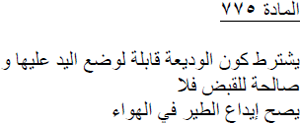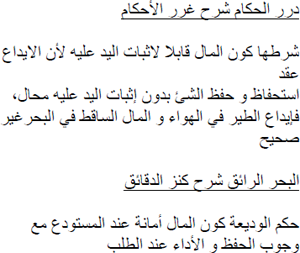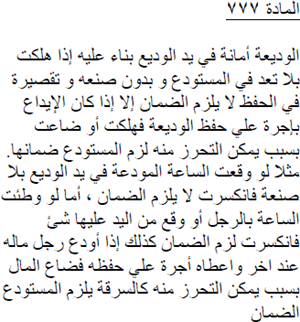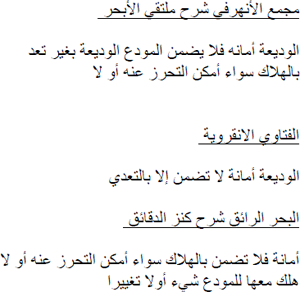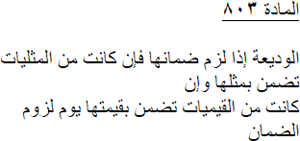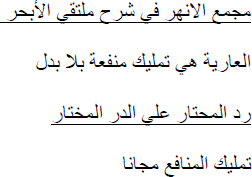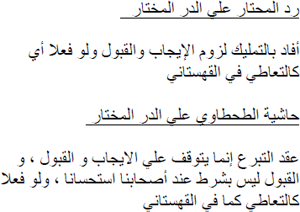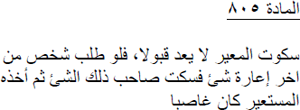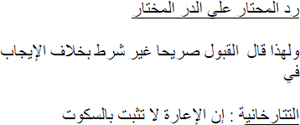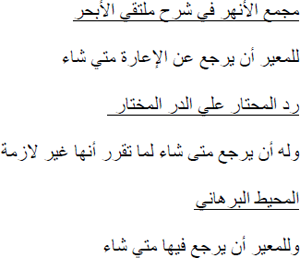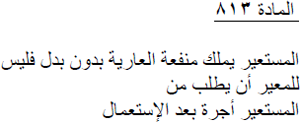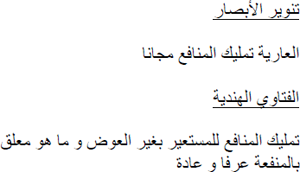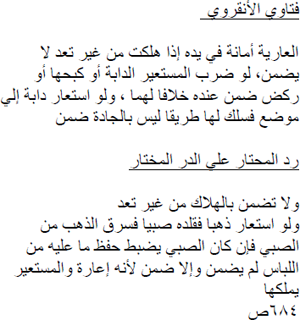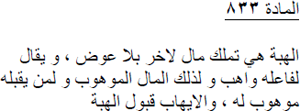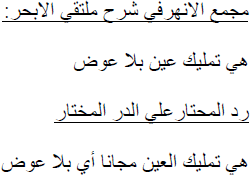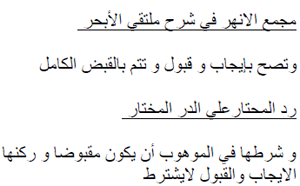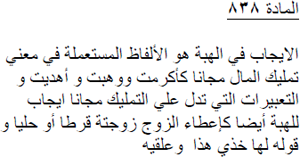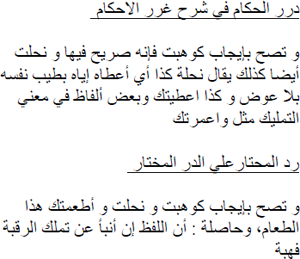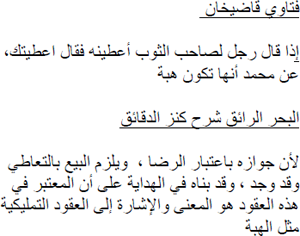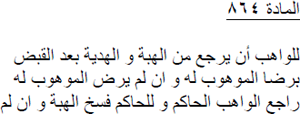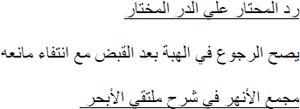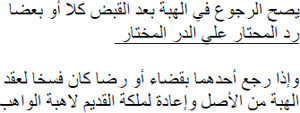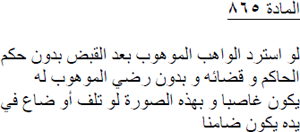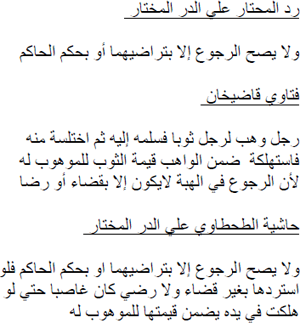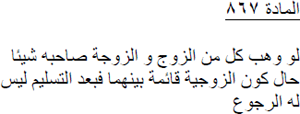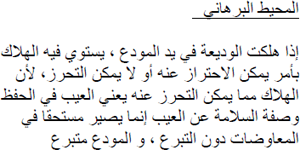The Mecelle, Sharia, and the Ottoman State: Fashioning and Refashioning of Islamic Law in the Nineteenth and Twentieth Centuries
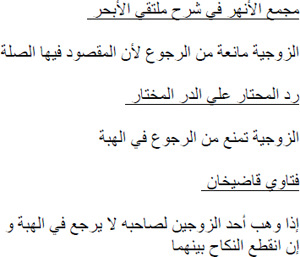
7The Mecelle, Sharia, and the Ottoman State Contemporary Islamic legal scholarship is preoccupied with the relationship between pre-modern articulations of Sharia and its modern formulations in the context of positive legislation and the nation-state. A key debate in the field is whether modern civil codes in Muslim majority countries and the codification of Sharia in the late nineteenth and early twentieth centuries are authentic representations of Islamic law or whether they are alien legal formulations authorized by the modern nation-state under heavy European influence. This article explores how the creation of the Mecelle, the first Islamic Civil Law code, in 1876 was justified by its drafters in terms of the indigenous legal genres within the Hanafi school. Thus, I address three central questions: (1) To what extent does the Mecelle embody Hanafi norms and doctrines? (2) What are the ways in which the Mecelle was justified as a legitimate Islamic legal code? (3) How does the Mecelle articulate new norms and doctrines in the name of the Hanafi tradition? I argue that the Mecelle articles are particularly faithful to late Hanafi jurisprudential norms and doctrines. The legal tradition of the late Hanafis (al-muta’akhkhirīn)1 of the early modern period serves as the legitimizing basis for the formation of the Mecelle, both in terms of its form and content. The Mecelle consistently adopts the opinions of the late Hanafis of the early modern period and their revisions of the madhhab. I provide examples based on the content of Mecelle articles and corresponding references to them in the late Hanafi tradition.2 The Mecelle perpetuates the role and authority of the Ottoman state in the Hanafi legal literature, which is reflected in references to sultanic orders and permissions.3 I situate the Mecelle, as an Ottoman state project, within the late Hanafi tradition to show how the Mecelle was justified based on the internal and indigenous mechanisms of the Hanafi school itself. The drafters of the Mecelle insisted that it was inspired by the existing legal genre of legal maxims (al-qawā‘id al-fiqhiyya) within the Hanafi school. References in the Mecelle and its commentaries specifically invoke the foundational work by Ibn Nujaym al-Hanafī al-Misrī (d. 970/1562–3), al-Ashbāh wa al-Nazā’ir, for justifying the legal form (i.e., pithily expressed principles) of the Mecelle. This work was very popular among Ottoman Hanafi jurists. For instance, Abū Sa‘īd Muhammad b. Mustafā b. ‘Uthmān al-Husaynī al-Khādimī (d. 1762) composed Majāmi‘ al-Haqā’iq, a work on legal theory (usūl al-fiqh), which incorporated Ibn Nujaym’s legal maxims as a conclusion to his work. This does not mean that some of the Mecelle articles did not depart from both early and late Hanafi legal norms. Many articles of the Mecelle departed from these formulations, but these changes were perpetuated through justificatory techniques within the Hanafi tradition itself. Therefore, I maintain that what is important about the Mecelle is not only that it represents a faithful synthesis of late Hanafi jurisprudential norms, but also it articulates new social and legal norms of the late Ottoman Empire. Furthermore, the key function of the Mecelle was to satisfy the need of the growing Ottoman bureaucracy to create a reference to the judiciary and other judicial councils, which lacked traditional Islamic legal training.4 I observed that Syrian and Anatolian Hanafi scholars were the prime participants in the formation of the Mecelle.5 There are two distinct features of the Mecelle: (1) the systematic nature of the project under Ottoman state supervision; (2) its function among the Ottoman legal regimes. This article proposes that the Mecelle should be understood in the context of the Ottoman modernization project in which it was a response generated from within the Islamic legal tradition to the Tanzimat and penetration of Western laws in Ottoman society.6 To support these arguments, I engage the discursive reasoning of the drafters of the Mecelle to affirm its faithful adoption of late Hanafi legal norms and doctrines. Therefore, I pay special attention to the report that accompanied the Mecelle, which serves as the rationale for its creation. I discuss how the function of the Mecelle is different from Hanafi jurisprudential works. I also examine one of the authoritative commentaries on the Mecelle to evaluate how it characterized the nature and role of the Mecelle within the Ottoman legal system. Moreover, I explore some case studies to demonstrate the underlying departures and doctrinal shifts from early and late Hanafi norms. The Mecelle (Ar. Majalla) is the first Ottoman attempt to codify Hanafi jurisprudence. The decision to draft the Mecelle resulted from a controversy over whether or not the Ottoman Empire should adopt the French civil code.7 The Ottoman Council of Ministers decided to commission a work based on Islamic jurisprudence and entrusted this task to a commission under the supervision of Ahmet Cevdet Pasha (d. 1895)8 who had been the leading advocate of this course of action.9 The committee included ‘Alā’ al-Dīn Ibn Ibn ‘Ābidīn (d. 1889), the late nineteenth-century Damascene Hanafi authority. The Mecelle was written and promulgated between 1869/70 and 1877. It contains 1,851 articles in sixteen volumes written in Ottoman Turkish.10 It covers contracts, torts, legal liabilities, and some principles of civil procedure.11 Officially, the Mecelle had jurisdiction throughout the Ottoman Empire, but in fact it was never effective in Egypt.12 In his İslam ve Osmanlı Hukukunda: Mecelle, Osman Kaşıkçı argues that the Mecelle was primarily dependent upon the Hanafi school.13 He stresses that the codification of the Mecelle was a response to Western legal hegemony.14 Yet, he asserts that the Ottoman officials were influenced by Western debates on law.15 The Mecelle was immediately translated into Arabic, Greek, and French under the title of “Ottoman Civil Law.” It served as the civil code in the Ottoman Empire, and briefly in the Turkish Republic, from 1869 to 1926.16 The Mecelle articulates two central issues in the late Ottoman Empire: (1) how Islamic jurisprudence responded to legal modernity; (2) the process by which Islamic law was able to articulate new ideals and values. The drafters of the Mecelle saw its creation as a rejection of Western legal hegemony over commercial litigation within the Ottoman Empire.17 The project of the Mecelle underscores the course of legal codification of Hanafi norms and doctrines in ways that provide insight into the process of legal development in the late nineteenth century. What I propose, then, is to understand the emergence of the Mecelle, not in terms of an epistemic break from pre-modern Islamic legal reasoning, but in terms of a continuation and transformation within the Hanafi legal tradition. The Mecelle cannot exist without dependence upon and articulation with previously existing norms and legal literature. The Mecelle did not appear ex nihilo, as a legal framework alien and opposed to the existing legal literature and legal order, but necessarily emerged out of an existing legal genre of qawā‘id and norms of late Hanafi tradition in a manner that made it an authentic representation of the legal tradition for the experts of the legal profession.18 This article explores how the late articulations of Hanafi jurisprudence point to both the continuous internal processes of doctrinal change within the madhhab and the indigenous legal paradigm upon which these changes were justified. For, the Mecelle is not only a rich site for interrogating competing legal doctrines within the Hanafi school, but also it represents the backdrop against which the codification of the Hanafi school and the canonization of its doctrines were completed. The Mecelle not only embodies the internal processes of legal change in the Hanafi school, but also it points to the legal, social, and economic changes within the late Ottoman Empire. These changes reflect the new emerging social, economic, cultural, and legal structures and orders. However, they were understood as a crisis of tradition not simply a crisis of adaptation to the new emergent social, political, cultural, and legal institutions. These transformations were generated both from within and outside the Muslim experience. From within, the social, economic, cultural, and political transformations of unprecedented magnitude put tremendous strain upon traditional legal institutions, legal values, and legal concepts. These societal changes deeply challenged the legal tradition as a whole, not merely a particular element in it.19 From outside, European legal hegemony started to be felt at the heart of the empire through European control of the litigation of most of the commercial activities and disputations involving European citizens within the Empire. The Ottoman Empire responded to these challenges by transforming its laws through radical centralization and bureaucratization. Ottoman legal change has been represented in some of the secondary literature mainly through the prism of westernization.20 For example, Joseph Schacht describes the project of the Mecelle stating: “The experiment of the Mejelle was undertaken under the influence of European ideas, and it is, strictly speaking, not an Islamic but a secular code.”21 He argues, “Strict Islamic law is by its nature not suitable for codification because it possesses authoritative character only in so far as it is taught in the traditional way by one of the recognized schools.”22 Moreover, Schacht recognizes that the Mecelle contains “certain modifications of the strict doctrine of Islamic law, particularly in the rules concerning evidence.”23 In addition, Bernard Lewis describes the efforts of the Mecelle committee as: “a digest rather than a code of Şeriat law of the Hanafi school . . . one of the great achievements of Turkish jurisprudence.”24 The Encyclopaedia of Islam introduces the Mecelle by stating, “it reflects Western influence mainly in its division into numbered books, sections and articles, as in European codes.”25 Some insist that the Mecelle is a deviation from the authoritative opinions of the school.26 Following the same discourse, without providing any evidence, some scholars have argued that the Mecelle is merely a random selection of legal doctrines from different schools of law.27 These positions consistently juxtapose the Mecelle with the Hanafi jurisprudence, arguing that it is a formalized legal project that was authorized by the state.28 Wael Hallaq, for instance, argues: “The transposition of Islamic law from the fairly independent and informal terrain of the jurists to that of the highly formalized and centralized agency of the state found manifestation in the Mecelle-ı Ahkām-ı Adliye.”29 He points out that a committee headed by the Sharia jurist Ahmet Cevdet Pasha produced it. Yet, Hallaq paints a picture in which the Mecelle was a result of a struggle between forces of tradition and Westernization. Hallaq pinpoints that Ahmet Cevdet Pasha insisted that the law had to be “faithful to the cultural constitution of the Empire against the powerful Westernizer Ali Paşa who called for the adoption of the French Code of 1804 (known as the Code Napoleon).”30 Hallaq contends, “One of the aims of the Mecelle was to provide, in the manner of a code, a clear and systematic statement of the law for the benefit of both the Sharia and Nizamiyye courts.”31 Erroneously, Hallaq claims that the opinions chosen did not necessarily reflect the authoritative doctrines in the Hanafi school. Moreover, he asserts that these doctrines were not exclusively Hanafi, for some of them were imported from other schools after being generally approved by the later Hanafis.32 The Mecelle, for Hallaq, was “a last-ditch effort to salvage the sharī‘a as a law in force, but it was also an attempted remedy applied to a problem that had originated as a remedy.”33 The main concern with Hallaq’s narrative is its dismissal of the arguments made by the drafters of the Mecelle that it is an authentic Islamic legal genre. He reduces its significance to a mere experimental project to rescue Islamic law at the end of the Ottoman Empire. Also, he disregards the stated intention of the Mecelle drafters as well as their justification for its formulation to burgeoning Ottoman bureaucracy and to expedite juridical litigation and court proceedings. Likewise, Hallaq overlooks the fact that ‘Alā’ al-Dīn Ibn Ibn ‘Ābidin, the Damascene Hanafi authority, after his father Ibn ‘Ābidīn, was a member of the committee that formulated the Mecelle. More seriously, Hallaq neither explains how the Mecelle deviates from the authoritative Hanafi opinions nor identifies which doctrines were borrowed from other schools of law. This narrative in the secondary literature fails to engage with the legal logic and discursive reasoning advanced by the drafters of the Mecelle. The Mecelle, as a systematic legal project, is modern in the sense that it responds to the emergent patterns of social, economic, and legal challenges of the mid-nineteenth century from within the Hanafi tradition. The drafters of the Mecelle never claimed that the codification of Hanafi jurisprudence was inspired by Western legal influence. The claim that the codification of Hanafi jurisprudence was a Western legal import is based on two assumptions: (1) Pre-modern Islamic law is alien to its modern articulations; (2) The dichotomy between the modern and the pre-modern is epistemic. The front cover of the Mecelle declares that it contains the shar‘i codes (al-qawānīn al-shar‘iyya) and juridical rulings (ahkām ‘adliyya) which, the Mecelle drafters maintain, are consistent with the authoritative manuals of Hanafi jurisprudence that were edited by a committee composed of established scholars and meticulous jurists. The Mecelle’s cover announces that the Sublime Porte approved the Mecelle and the imperial rescript established it as the canon, exemplar (dastūr) to be acted upon.34 The Mecelle is commenced with the report that was filed to the late Ali Pasha, the Grand Vizier (al-Sadr al-Azam) on 1 Muharram 1286 (13 April 1869) justifying and situating the significance of its formation among the different legal regimes in the Ottoman Empire. The report was signed by the principal of the Dīwān al-Ahkām al-‘Adliyya, Ahmet Cevdet Pasha; the inspector of the Imperial Endowments, al-Sayyid Khalīl; members of the Shūra al-Dawla, Sayf al-Dīn and Muhammad Amīn al-Jundī; and members of the Dīwān al-Ahkām al-‘Adliyya: al-Sayyid Ahmad Khulūsī and al-Sayyid Ahmad Hilmī; and a member of the Committee, ‘Alā’ al-Dīn Ibn Ibn ‘Ābidīn. The filed report is dated 8 Dhūl Hijja 1285/10 March 1869. The report asserts that Islamic jurisprudence is the locus of the matters related to everyday life. It explains that fiqh is divided into personal status (munākahāt), transactions (mu‘āmalāt), and criminal punishments (‘uqūbāt). These same three categories, the report insists, are the principles of laws of civilized nations and it declares that the category of transactions (mu‘āmalāt), in this legal scheme, is called the Civil Law.35 The report confirms that Islamic jurisprudential norms are adequate to address all commercial cases that might be tried in courts.36 Aware of the legal developments and legal regimes in Europe, the report attributes the three legal categories (munākahāt, mu‘āmalāt, and ‘uqūbāt) to both the Islamic and European systems. The report does not claim that the legal systems of Europe are models for the Mecelle. Instead, the report affirms that Islamic jurisprudence is sufficient to address any of the emerging commercial activities and disputations. The report states: The Sublime Porte has, historically and recently, enacted many laws similar to the Civil Law and although these laws are insufficient to explicate all commercial activities, the cases that fall under the commercial transactions from the science of fiqh (jurisprudence) is sufficient and satisfy the recurrent needs in this regard and [avoiding] what is observed of some problems occur in referring claims to shar‘ and kanun.37 Furthermore, to affirm the sovereignty of the Sharia, the report reiterates that Islamic jurisprudence is the authoritative reference of the principal origin of laws and the imperial legal regulations. It emphasizes that cases that are litigated according to the imperial statutory law (nizam) are decided based on Islamic law. The Mecelle emphasizes that European laws should not be a reference in any litigations within the Ottoman Empire because the imperial rescript did not enact these laws; therefore, they do not constitute a source of law in Ottoman state courts.38 Additionally, the report touches on a key problem facing the different judicial bodies that were created in the Ottoman Empire, namely, the lack of traditional Islamic legal training. The report establishes that the science of fiqh is a “sea without a shore” and the process of deducing the core principles of the cases to solve these problems is contingent upon scientific skill and legal craft, especially in the Hanafi school. The report explains that the madhhab has many independent legal scholars (mujtahidūn), yet they differ based on their generation and authoritativeness, adding to the plurality of the opinions [in the madhhab]. The report laments that the Hanafi school has not been standardized, in contrast to the Shafi‘i school. In the Hanafi school, the report claims, the jurisprudential cases still suffer divergence and thus distinguishing the sound authoritative opinion among these divergent opinions and applying the new emergent cases based on them is extremely difficult.39 To justify changes to key Hanafi doctrines and norms in the Mecelle, the report relies on the concepts of custom, changes of time, and necessity, which are part and parcel of Hanafi legal reasoning.40 This process confirms that the doctrinal shifts in the Mecelle were perpetuated from within the madhhab and were a continuation of an internal mechanism. In this context, the report emphasizes that changes of time affect changes in legal rulings of cases that are based on tradition (‘āda) and customary practice (‘urf). The report provides the following case. According to early Hanafi jurists, if someone wanted to purchase a house, it would have been sufficient for the buyer to see one of its rooms to finalize the sale. However, late Hanafi jurists insisted that it was necessary for the buyer to see each room in the house individually. The report asserts that this shift of opinion is not based on the introduction of new evidence, but it rises from a change in tradition and custom pertaining to the matters of house construction. The report explicates that the old tradition in building houses used to have very similar rooms and styles, thus, to see one of the rooms would be considered a valid sight of all rooms in the house. In this age, however, the Mecelle report postulates that the established custom of the day stipulates that houses now have different rooms with different styles and spaces. Therefore, it is necessary to see every room at the time of purchase.41 The new guiding principle that was formulated due to this change of custom is the attainment of a sufficient knowledge of the purchased item. The drafters insist, “The shift of legal ruling in this case is not enabled due to a change of a legal principle but rather a change for the legal ruling based on the change of circumstances of the time.”42 The report asserts the importance of codification in the following manner. First, it points out that the exhaustion of the knowledge of all prior Hanafi fatāwā was already an extremely difficult task. The efforts of legal scholars could not encompass all the jurisprudential cases and accommodate all intra-madhhabic differences.43 Second, the report introduces the importance of legal maxims in the process of legal reasoning and judicial proceedings. It explains that Ibn Nujaym gathered many of the jurisprudential canons and overarching legal principles under which the particular cases of jurisprudence are treated. The report insisted that Ibn Nujaym’s work opened up a new window that would facilitate the knowledge of the particular cases in the school.44 Third, the report claims, in our time, it is rare to find those who possess this deep shar‘i knowledge in all fields, let alone that it is impossible to appoint members to the Nizamiye courts possessing the ability and skill to review manuals of jurisprudence at a time of need to solve emergent problems. Also, the report reveals that it has become difficult to find enough judges for the Sharia courts that already exist in the provinces of the empire.45 For these reasons, the report justifies the necessity for the creation of the Mecelle. The Mecelle was considered an easy text to read, free from any legal disputation, and contained the most preponderant opinions in the Hanafi school. In other words, Ottoman state officials, judges, members of the new Nizamiye courts, and administrative employees can confidently rely upon the Mecelle in their legal determinations.46 The drafters stress that in the process of formulating the Mecelle they were cognizant of the Hanafi madhhab doctrinal boundaries and its authoritative opinions: We were assigned, despite our weakness and inability, to be responsible for completion of this great project and good sign to satisfy the current commercial activities and transactions based on the jurisprudential canons fulfilling the needs of this age. Upon the Imperial will, we gathered in the Diwān al-Ahkām and took the initiative to organize the Mecelle containing the many cases and matters that are frequently recurrent and represent an urgent necessity from the jurisprudential commercial activities. They are gathered from the legal authentic opinions of the Hanafi scholars and they were divided into various chapters and were labeled “al-Ahkām al-‘adlīyya”.47 The report informs us that after the completion of the introduction and first book of the Mecelle, a copy of both were given to the Ottoman religious establishment (mashyakhat al-Islām), and other copies were sent out to authoritative scholars who possess sufficient skill and knowledge in the science of fiqh.48 The reason for these scholarly screenings was to confirm both the legitimacy of this work as a representative of Islamic legal literature and the accuracy of its Hanafi content. Upon reading this report, it becomes clear that the Mecelle was created to fulfill a specific judicial function within the Ottoman bureaucracy. Also, it appears that the legal maxims and the books of fatāwā were essential in the formulation of the Mecelle. Most importantly, these works are the loci for the revised opinions and norms found in the late Hanafi tradition. The Mecelle was not meant to be a substitution of the process of legal reasoning, but it was thought of as a framework through which judges and state employees could reason about the filed cases. One of the most important aspects of the Mecelle is that it signifies the creation of a legal genre that is solely dedicated to judicial reasoning and court procedures. It is through this understanding that we can grasp the treatment, function, and role of the codified Hanafi legal norms in a single project. While the Mecelle elaborates on the important function of fiqh to preserve human life, perpetuate civilization, and to protect social and moral order, it appears to also have an entirely different function. The Mecelle encapsulates the “judicial” (qadā’ī) aspect of fiqh.49 In other words, the purely religious and ethical considerations are not the objective of the codification of the Hanafi legal doctrines.50 The six categories that qualify human actions in the Hanafi fiqh—obligatory (fard), duty (wājib), prohibited (harām), recommended (mandūb), reprehensible (makrūh), and permitted (mubāh)—are not incorporated into the process of legal reasoning in the judicial process.51 The main function of the Mecelle was to influence judicial reasoning and to expedite court proceedings. The categories of “recommended” and “reprehensible” are more intertwined with the fatāwā discourse. Most importantly, these ethical categories are designed to address the conscience of the believers (diyāna) and to promote piety and good behavior. Islamic legal practice already distinguishes between these two categories of legal classifications: judicial and moral/religious.52 Islamic law recognizes the fact that “the individual may violate a religious duty without subjecting oneself to the sanction of the judicial prosecution.”53 The Mecelle, as a legal project, specifically addresses the needs of the judiciary and the new “secular” and Sharia court systems in the Ottoman Empire in the late nineteenth century. The intent of the drafters of the Mecelle was not to reproduce a fiqhī text, but to stipulate standardized criteria for judicial reasoning. The Mecelle discusses the role and function of fiqh in society in Article One. Article One states that fiqhī issues are either related to the Hereafter, namely, al-‘ibādāt (ritual acts); or they are concerned with worldly affairs, namely, munākahāt (personal status), mu‘āmalāt (transactions), and ‘uqūbāt (punishment).54 The Mecelle asserts that since human beings—unlike animals, are civil by their nature—they are driven to live in communities and not on their own. Humans, therefore, need to cooperate and collaborate in order to preserve civilization.55 However, because it is also in human nature to seek what s/he desires and would fight whomever competes with him/her to reach his/her goal, it is necessary to establish laws to maintain justice and order. In particular, this situation requires the establishment of laws in the matter of personal status, which is the munākahāt division of fiqh.56 Also, human beings need laws to protect civilization—which is maintained by cooperation and collaboration—and these fall under the mu‘āmalāt division of fiqh. Finally, human beings require laws of punishment to preserve the continuity of civilization in this ordered manner. These laws belong to the ‘uqubāt division of fiqh.57 Thus, it is through fiqh that the moral-social order is guaranteed and that civilization is maintained and sustained. The Mecelle enumerates few examples in which the opinions of the Hanafi school have shifted from its pre-modern articulations to reflect new legal and social norms. The justification for such changes varies among the cases provided. Murteza Bedir rightly argues, “All of the provisions formulated by the Mecelle Committee in the nineteenth century were more or less in conformity with the recognized opinions of the Hanafi school.”58 Yet, Bedir asserts that the formulation of the preferred opinions (rājih) that ended up in the Mecelle was driven by “new considerations.” Bedir claims that the authors of the Mecelle articulated this new idea in the report that accompanied the Mecelle, stating, “nasa erfak ve asrın maslahatına evfak” or “that which is easiest for the people and the most suitable for contemporary needs.”59 Bedir contends that the drafters of the Mecelle “used this maxim as the sole justification for their singling out a particular opinion and promulgating it as the law on a given case.”60 Bedir’s assessment that the doctrinal shifts in the Mecelle were solely driven by people’s needs requires attention. The Mecelle report gives us a unique glimpse into the logic and discursive reasoning of the deliberations within the Mecelle committee on this issue. The Mecelle shifts from the hierarchical authoritative positions of the Hanafi school to alternative positions within the same school based on masālih al-nās (people’s interests), taysīr mu‘āmalāt al-nās (facilitating people’s transactions), mura‘āt maslahat al-waqt (taking into consideration the interests of the due time), and mura‘āt al-‘urf (considering customs and tradition). Strictly speaking, these techniques are no different from premodern Hanafi jurisprudence. Also, the late Hanafi revisions of the early authentic opinions in the madhhab (zāhir al-riwāya) were carefully incorporated into the Mecelle. It is in this context only that we can make sense and appreciate the drafters’ insistence:61 Because we have not departed from the doctrinal boundaries of the Hanafi school, and since the greater part of those articles published in the Mecelle are consistent [essentially true in spirit] with the currently valid and observed opinions of the House of Religious Edicts (fetva hane), there is no need for a discussion about them. The opinions of certain key jurists of the Hanafi school are more suitable to the peoples [needs] and to the interest of this age and thus we have admitted them within the Mecelle [as well as the madhhab], and we give below our justification and reasons [report of the mecelle].62 The Mecelle drafters shifted some opinions of the school by utilizing the justificatory techniques and tools available for Hanafi jurists. For instance, in Articles 85 and 197, the Mecelle stipulates that the sale of non-existent things is void. However, the current situation, the Mecelle committee elaborates, is that things such as flowers, artichokes, vegetables, and fruit (representative crops that do not all grow at the same rate—some flowers will bloom before others; some fruit will ripen early, others later) are valid for sale even if only some of the expected yield is successfully grown. Since it is not possible for any crop to grow altogether at the same time, people agreed on the custom of contracting the sale of the entire potential yield—the existent and those expected to grow—in one commercial deal. The origin of the Hanafi support for this custom is Muhammad b. al-Hasan al-Shaybānī, who permitted this type of sale based on juristic preference (istihsān), and justified it by arguing that the existent should be considered the basis of the commercial transaction (al-asl) and the non-existent to follow it in its ruling. This opinion was the basis of the fatwā by the Bukhāran Shams al-A’imma al-Hulwānī (d. 1056), and Abū Bakr b. Fadl (d. 1118). The Mecelle drafters affirm that forcing people to give up one of their established customs is not possible. The priority is to consider their transactions to be valid; therefore, the drafters of the Mecelle chose Muhammad’s opinion to preponderate in this case.63 Mecelle-i ahkâm-i adliye (Istanbul: Matbaa-yi Osmaniye, 1882) Similarly, according to Abū Hanīfa, the person who is engaged in a manufacturing contract (istisnā‘) has the right to withdraw from the contract; however, Abū Yūsuf argued that if the person found the manufactured product in accordance to the criteria that were stipulated and approved in the contract, he cannot withdraw from the contract. As a clear shift from Abu Hanīfa’s position to Abū Yūsuf, the Mecelle asserts that due to the current situation “in our times,” there are many factories where canons, ships, and the likes are produced through manufacturing contracts, thus, it became clear that giving the choice to the buyer alone to finalize or nullify the contract would result in violating substantial interests of one of the contracting parties. In this situation, it is incumbent to choose the opinion of Abū Yūsuf considering the interests of “our time,” as it was declared in Article 392 of the Mecelle.64 Many authors were inspired by the Mecelle to write commentaries on it. These authors—lawyers, scholars, and judges who had direct contact with legal and judicial litigation in the empire—usually start off their works by justifying the necessity of the Mecelle project and explaining its functions and the key jurisprudential canons incorporated within its articles. It appears that these Mecelle commentaries garnered their legitimacy as well as the license to be published after their approval by the Ottoman legal establishment. Moreover, these commentators unanimously affirm that the Mecelle was based on authoritative late Hanafi legal commentaries. They refer the reader to late Hanafi works that make the connection between the Mecelle articles and late Hanafi jurisprudence, such as al-Durr al-Mukhtār and its commentaries, al-Bahr al-Rā’iq, al-Nahr al-Fā’iq, Majma’ al-Anhur, and Abū Sa‘īd al-Khādimī’s Majāmi‘ al-Haqā’iq. Here, I limit myself to one of the authoritative commentaries in the field, namely: Durar al-Hukkām Sharh Majallat al-Ahkām. I explore how this commentary discussed the project of the Mecelle, and how the commentator viewed the relationship between Mecelle and the late Hanafi legal tradition. Also, I discuss how this commentary understood the role of legal maxims in the process of legal reasoning. In his Durar al-Hukkām Sharh Majallat al-Ahkām, Alī Haydar (d. 1935), a prominent Ottoman judge and lawyer, reiterates that legal scholars agree that the science of fiqh is a “sea without a shore,” and that the extraction of the key principle is contingent upon a “sublime skill and established knowledge.”65 Haydar follows the Mecelle by asserting that the authoritative Hanafi commentaries have plenty of differences. In his opinion, summarizing the preponderant opinions with the supporting evidence and collecting them in a significant work, such as the Mecelle is one of the most difficult matters in need of careful research and investigation. Haydar explains that due to his career in the Ottoman judicial system, he was able to record some key and subtle cases by collecting them in a commentary on the Mecelle. Haydar emphasizes that the Mecelle was extracted from fiqh; thus, a commentary on it should explicate its articles based on fiqh manuals. Also, he affirms that it should be in agreement with the opinions that were chosen by the Mecelle drafters. Haydar points out that the scholars and jurists in the High Fatwā Council reviewed this work. His commentary was approved because it “agrees with al-shar‘ al-sharīf,”66 meaning that it was consistent with the current norms of jurisprudence. We observe that Ottoman Hanafi jurists, and especially their fatāwā works, significantly influenced later Hanafi legal articulations as reflected in the Mecelle. Ottoman Hanafi jurists were immensely ingrained in the Hanafi legal tradition, and they were able to employ the techniques of the tradition to revisit, suspend, or introduce legal rulings. The ideational framework for the Mecelle is important for evaluating the Hanafi texts consulted and whether or not the Mecelle is faithful to the Hanafi tradition. The following three case studies pinpoint the process by which the Mecelle drafters embraced and preserved Hanafi norms and categories, and transformed key doctrines to produce standardized judicial rules to guide litigation. The transformations that were introduced in the Mecelle were justified from within the Hanafi legal tradition and in the name of its authorities. Many of these doctrines in the Mecelle—which clearly rescind early Hanafi doctrines—were incorporated in the late Hanafi tradition as part of its organic doctrinal development. Although the introduction of the Mecelle alludes to a few cases of legal change within the Hanafi school, I located many other subtle transformations within the Mecelle articles. One of the central aspects of the Mecelle is that it confirms a process of legal continuity and change by which Hanafi doctrines were shifted or altered. This early modern process relies upon techniques similar to those in late Hanafi legal literature in order to address a new social reality. In the introduction to the chapter on wrongful appropriation (ghasb), the definition of ghasb in the Mecelle does not reflect its classical authoritative provisions stated by Abū Hanīfa and Abū Yūsuf. Instead, the stated definition in the Mecelle endorses the opinion of Muhammad b. al-Hasan al-Shaybanī over the professed opinion of the school.68 The Mecelle, unlike the classical definition, defines ghasb in Article 881 as the act of taking and seizing someone’s mal without the owner’s permission.69 It explicates that the one who wrongfully takes another’s property is called usurper (ghāsib), the seized mal is called usurped (maghsūb), and the valid owner of the usurped property is the one whose property is usurped (maghsūb minhu).70 Clearly, the Mecelle turns away from the definition of ghasb coined by Abū Hanīfa and Abū Yūsuf, who conditioned the ability of the usurper to affect legal actions (selling, buying, etc.) into the usurped objects in order to be considered a ghasb.71 By contrast, Muhammad b. al-Hasan al-Shaybānī only stipulated the act of seizing mal without the owner’s permission. This change of the concept of ghasb as a legal concept does not only express the internal development of the school, but also addresses the new social realities and commercial activities within the empire. At the same time, the Mecelle adheres faithfully to key late Hanafi doctrines and norms. For instance, Article 887 of the Mecelle reinstates the premodern Hanafi doctrine in the cases of duress, wrongful appropriation, and spoilage. Article 887 states, “causing damage by direct causality (mubāsharatan) is to cause direct damage to the object itself. The one who causes this damage is called mubāshir.”72 This doctrine is further explained in Article 888 in which the Mecelle defines secondary causality (tasabbuban) as the inflicting of damage on another with [full knowledge of how such an action would cause damage]. The one who commits this act is called mutasabbib. An example of this is a person who cuts the rope of a hanging lamp: this person would be the cause for its fall to the ground, as well as the secondary cause of any damage to it. The cutting of the rope is by direct execution (mubāshara), while the damage to the lamp is by secondary causation (tasabbub).73 By the same token, the Mecelle follows the late Hanafi formulations in Article 890. It demands the return of the usurped mal to its rightful owner at the location of wrongful appropriation. Yet, if the mal’s valid owner and the usurper met by a sheer accident in a different place (country) and the seized mal is with the usurper, the owner would have the option either to recuperate his mal at this location or request to reacquire his mal in the location of the wrongful appropriation. In this case, the usurper will shoulder the financial cost of transporting the usurped object.74 Additionally, the Mecelle establishes the central doctrine of transgression (al-ta‘dī), which is the sole criterion that triggers financial liability in the late Hanafi legal reasoning. According to Article 898, if the usurper changed some of the intrinsic features of the usurped material by spending some of his money on it, the valid owner would have the choice: (1) to give the money for the extra value and recuperate his exact usurped thing; (2) to hold the usurper financially liable for the whole value of the object.75 For example, if the usurped substance is a garment and the usurper dyed it, the valid owner would have the choice either to ask for financial compensation for the garment or he may give the usurper the value of dying and be returned his garment.76 The Mecelle adopted late Hanafi revisions of persistent early Hanafi doctrines on the rejection of imposing any liability for the manāfi‘ (profitable utility). It also incorporates late Hanafi opinion on the issue of zawā’id (natural outgrowth) of the usurped objects. For instance, Article 903 affirms that the zawā’id of the usurped substances belongs to its valid owner.77 If the usurper consumed them, he will be held financially liable for them. Thus, if the ghāsib consumed the baby of a usurped animal that was born during his possession of the animal, he will be liable for it. The same applies to the case of the fruits of a usurped garden. The Mecelle gives a third example of a usurped apiary, the valid owner would also reclaim the value of what was produced while the apiary was in the possession of the usurper. In short, the Mecelle sets out a revised doctrinal attitude of affirming financial liability for both the manāfi‘ and zawā’id of the usurped objects. Moreover, these remedial rules of wrongful appropriation of property are addressed in Article 905 in the Mecelle. It states that the usurper must return the usurped property to its owner without changing it or decreasing its value. Yet, if the value of the property decreased due to an action by the usurper, he would be financially liable for its value. Also, if someone destroyed the location of the usurped house or it was damaged because of his residence, which resulted in the decrease of its value, the usurper would be liable for the decreased value. Also, if a house were burned down by fire that was lit by the usurper, he would be financially liable for its value.78 The most important shift, in my view, was transforming the definition of ghasb in the legal literature of the Mecelle to reflect the transformation of the madhhab opinions, not breaking with its fundamental norms by shifting from the authoritative opinions of Abū Hanīfa and Abū Yūsuf to the opinions of Muhammad al-Shaybānī. Thus, even this change was induced within the internal plurality of the school opinions from within its hierarchical positions. The Mecelle settles completely the issue of accepting written proofs as sufficient legal evidence in courts. Late Hanafis specifically address this issue in their legal commentaries. For instance, Ibn ‘Ābidīn shows the gradual acceptance of some types of written proofs such as imperial edicts, sultanic decrees, endowment registers and court records. He explains that ‘Alā’ al-Dīn al-Haskafī accepts these types of written documents as legal proofs once they are cleared of fraud or forgery.79 This is also the same position of most of the Ottoman Hanafi jurists.80 However, Ibn ‘Ābidīn points out that Khayr al-Dīn al-Ramlī (d. 1671) showed resistance to accepting written documents as sufficient proofs to endowment claims.81 Most importantly, the process by which Ibn ‘Ābidīn is able to accept some of these written documents as legal proofs is by introducing exceptions to the rule.82 By contrast, the Mecelle discusses this issue under the title, “Written Proofs,” in which it stipulates the acceptance of all authenticated written proofs in four Articles. First, in Article 1736, the Mecelle states that a sultanic decree or a seal—on its own—has no legal validity, but if they are established to be free from forgery and imitation, they have full demonstrative proof in court. Second, in Article 1737, the Mecelle stresses that imperial assignments/certificates (berats) and the books of the management of the Land Registry Office have full demonstrative force because they are secure against every kind of fraud. Third, in Article 1738, the Mecelle accepts court registers and grants them full demonstrative force as valid legal proofs, if they are exact and clear of any forgery. Fourth, in Article 1739, the Mecelle declares that endowment certificates are valid as legal proofs as long as they are registered in authentic court records. In the discussion of the required qualification of the witness, the Mecelle requires all traditional qualifications of a witness, but not the quality of being a Muslim.83 In a complete departure from Hanafi legal thought,84 the section on testimony and evidence in the Mecelle does not address the religion of the witnesses. The focus is primarily on the exactitude and justice of the witness as well as his/her reputation in Article 1705. The just person is defined in the same article as the one whose good deeds are dominant over his/her bad deeds.85 This is the first time in Islamic jurisprudence that the religious identity of the witness is not considered as an issue affecting the validity of a testimony. Although Islamic jurisprudence acknowledges the testimony of non-Muslims in courts, it consistently resisted the testimony of non-Muslims against Muslims.86 The Mecelle shifted these norms and introduced more egalitarian conditions for valid testimony in front of a judge. It also reflects the frequent complaints of the European powers that their citizens could not litigate in front of the Sharia courts because their testimony was not accepted against Muslims in cases of litigation. The drafters of the Mecelle maintained that it was inspired by the already existing genre of legal maxims (al-qawā‘id al-fiqhiyya) within the Hanafi school. The emergence of the Mecelle should be understood, not in terms of an epistemic break from the Islamic legal reasoning, but in terms of a continuation and transformation within the structure of a legal tradition. The Mecelle necessarily emerged out of an existing genre of qawā‘id in a manner that made it an authentic representation of the legal tradition for experts of the profession. Moreover, the Mecelle itself was circulated among legal authorities and the Ottoman religious establishment to approve it and endorse its formation, as an indispensable process of legitimacy. The articles of the Mecelle are not randomly selected norms or doctrines from the Hanafi legal tradition as has been claimed by some scholars. The central doctrines codified in the Mecelle as well as its predominant articles are faithful to late Hanafi opinions. Still, some legal doctrines of premodern Hanafi jurisprudence were transformed in the Mecelle through the internal mechanisms and rationalization of the madhhab, such as customs, change of time, and necessity. These shifts should be understood within the Hanafi doctrinal development, because they are justified in the name of the madhhab and its authorities. The Mecelle represents a shift in the function of the law in the late nineteenth-century Ottoman Empire. This function changed to reflect new emergent state institutions. In this context, Hanafi jurisprudence was called to address this transformation and fulfill this role. While I acknowledge that continuity and change are key features of the premodern Islamic jurisprudence, the scale of transformation reflected in the Mecelle and its new function denote that it was formulated to address specific circumstances. The Mecelle as a systematic codification of a legal tradition successfully incorporated and introduced new “modern” concepts and premises, such as the systemic distinction between public and private property, the restriction of absolute authorities (wilāyat), revisiting key remedial rules and legal liabilities (damānāt), and the introduction of new types of contractual agreements (‘uqūd). The Mecelle introduced these changes by rooting them into the legal tradition itself, reflecting a new legal order. Additionally, one of the purposes of the Mecelle was the standardization of legal and judicial reasoning. The Mecelle was the first step in the process of developing a written law that was designed to assist judges to render similar legal judgments on similar issues. While I affirm that the context that shaped the discussions around the Mecelle is intertwined with the questions of Western hegemony, the key issue in the minds of the drafters of the Mecelle was how to formulate an Islamically informed response to Western hegemony.87 The Mecelle is not only a manifestation of such debates and a response to these questions, but also a successful strategy to meet the demands of the Ottoman bureaucracy. The Mecelle is particularly faithful to the late Hanafi doctrines and norms. The drafters of the Mecelle imagined themselves within the madhhab, as active participants and contributors to it. For instance, the Mecelle adopts Ibn Shubruma’s opinions, leaving behind Abū Hanīfa’s opinion, on stipulating conditions for the sale of contracts on the basis of customary practice among craftsmen. Some late Hanafis invoke Ibn Abī Laylā’s and Ibn Shubruma’s opinions to depart from Abū Hanīfa’s opinions.88 As I have shown, the Mecelle embodies the daunting and complex process in which the legal and doctrinal change targeted a nucleus of legal concepts and values to be replaced with “new” norms and doctrines for which the Hanafi tradition was the point of departure. These changes and transformations are not achieved in opposition to the legal tradition. Rather, this tradition, in its various articulations, is invoked to address the foreign legal hegemonies by asserting, revising, and rescinding its own norms and doctrinal boundaries. The problem with attributing any legal or doctrinal change in the Hanafi school during the late nineteenth century to the influence of European codes is that it overlooks the process by which legal transformation was entrenched in legal tradition itself. Also, what is “modern” about the transformation of Hanafi legal doctrines in the Mecelle is not that it imitates European codes, but the underlying premises that the Mecelle is trying to articulate from within an Islamic legal tradition. Most importantly, the point of departure for Muslim lawyers has always been Islamic legal tradition. In short, the Mecelle, at its core, is a Muslim response to modernity and its legal order argued and justified from within the tradition. SAMY AYOUB is a lecturer in Islamic Studies at the University of Texas, Austin. Thematic tables of the Mecelle Articles: I. Deposit for Safe-Keeping (al-Wadī‘a) The Mecelle Articles Hanafi Works II. Trusts and Trusteeship (al-‘Āriya) The Mecelle Articles Hanafi Works III. Gift Giving (al-Hiba) The Mecelle Articles Hanafi Works 1.Late Hanafism emerged ca. eleventh century CE. It developed into a fully-fledged tradition in the Mamluk period and early modern Ottoman Empire. Late Hanafi jurists declared their own distinct identities, opinions, and consensus in relation to earlier Hanafi opinions. See Abd al-Ḥayy al-Laknawi, ‘Umdat al-Ri‘aya ‘ala sharḥ al-Wiqaya (Beirut: Dar al-Kutub al-‘Ilmiyya, 2009), 15–6. 2.See Appendix A. I give examples from three different chapters of the Mecelle, namely: Chapters on Deposit for Safe-Keeping (al-Wadī‘a), Trusts and Trusteeship (al-‘Āriya), and Gift Giving (al-Hiba). 3.Alī Haydar Efendī, Durar al-Hukkām fī Sharh Majallat al-Ahkām, (Cairo: Dār al-Jīl, 1991), 598. See the following Mecelle Articles 1152, 1272, 1276, 1280, 1281, 1287, 1801. 4.Recep Şenturk, “Intellectual Dependency: Late Ottoman Intellectuals between Fiqh and Social Science,” Die Welt des Islams 47 (2007): 295. Şenturk argues that the Ottoman bureaucrats saw that the modern state structure was incompatible with the legal pluralism of the Ottoman Millet System in which religious communities were allowed to follow their legal traditions in litigation. Also, he argues that late Ottoman officials were attempting to create modern Islamic law out of the traditional structures of fiqh. 5.The Egyptian Hanafi scholars are excluded due to the political tension between the Porte and the almost-independent Egypt. 6.Şenturk, “Intellectual Dependency,” 294. 7.Wael B. Hallaq, Sharī‘a: Theory, Practice, and Transformation (Cambridge: Cambridge University Press, 2009), 411. 8.Al-Ziriklī, al-‘Alām, 1:108. Ahmet Cevdet b. Ismā‘īl b. Alī b. Ahmad Agha was a Turkish minister. He travelled to Istanbul and studied Arabic and sacred sciences. He also studied law and was appointed a judge for a brief time. Then, he was appointed the head of the Ministry of Justice. 9.C.V. Findley, “Medjelle.” Encyclopaedia of Islam, 2nd ed. (Brill Online, 2013); Şenturk, “Intellectual Dependency,” 298. 10.There is a tradition of Hanafi jurisprudence authored primarily in Ottoman Turkish. This is reflected in the Ottoman fatāwā collections, legal epistles, or complaints filed to the Ottoman muftis in the imperial capital. 11.Findley, “Medjelle.” 12.Talal Asad, Formations of the Secular: Christianity, Islam, Modernity (Stanford: Stanford University Press, 2003): 211. 13.Osman Kaşıkçı’s work is a key secondary source, which offers a detailed documentation of the process of the formation of the Mecelle. Kaşıkçı provides original documents in Ottoman Turkish which include the meeting minutes, reports, and the final proceedings of the Mecelle committee. He provides some insights into the role of Hanafi jurists and fatāwā literature in the formation of the Mecelle. 14.Osman Kaşıkçı, İslam ve Osmanlı Hukukunda: Mecelle (Istanbul: Osmanlı Araştırmaları Vakfı, 1997), 52–5. 15.Osman Kaşıkçı, İslam ve Osmanlı Hukukunda, 52–5. 16.Findley, “Medjelle.” 17.al-Majallah: wa-hiya tahtawī ‘alā al-qawānīn al-shar‘īyah wa-al-ahkām al-‘adlīyah al-mutābiqah lil-kutub al-fiqhīyah, 2nd ed. (Qustantīnīyah: al-Matba‘ah al-‘Uthmānīyah, 1887), 4–5. 18.The Mecelle incorporates Ibn Nujaym’s qawā‘id from Article 2 to Article 100. These maxims pertain to the broad understanding of the Hanafi fiqh literature and its legal discourse. Murteza Bedir, “Fikih to Law: Secularization through Curriculum,” Islamic Law and Society 11:3 (2004): 386. See Sobhi Mahmassani, Falsafat al-Tashri fi al-Islam: The Philosophy of Jurisprudence in Islam, trans. Farhat Ziadeh (Leiden: Brill, 1961 [1946]), 42–7. The argument in this article situates the Mecelle within the larger context of late Hanafi tradition. 19.David Luban, Legal Modernism (Ann Arbor: University of Michigan Press, 1994), 28. 20.Avi Rubin, Ottoman Nizamiye Courts: Law and Modernity (New York: Palgrave MacMillan, 2011), 15; Şenturk, “Intellectual Dependency,” 284; Dora Glidewell Nadolski, “Ottoman and Secular Civil Law,” International Journal of Middle East Studies 8:4 (1977): 518; Shirine Hamadeh, “Ottoman Expressions of Early Modernity and the ‘Inevitable’ Question of Westernization,” The Journal of the Society of Architectural Historians 63 (2004): 34; Avi Rubin, “Ottoman Judicial Change in the Age of Modernity: A Reappraisal,” History Compass 7:1 (2009): 123. 21.Joseph Schacht, An Introduction to Islamic Law (New York: Oxford University Press, 1982), 92. 22.Ibid. 23.Ibid., 93. Schacht argues that the Mecelle requires all traditional qualifications of a witness and his evidence, but not the quality of being a Muslim (art. 1684). Schacht’s observation is accurate in that the section on testimony and evidence in the Mecelle do not address the religion of the witnesses. The focus is primarily on the exactitude and justice of the witness as well as his/her reputation (art. 1705). The just person is defined in the same article as the one whose good deeds are dominant over his/her bad deeds. 24.Bernard Lewis, The Emergence of Modern Turkey (New York: Oxford University Press, 1968), 123. 25.Findley, “Medjelle.” 26.Abdullahi Ahmed An-Na‘im, “The Compatibility Dialectic: Mediating the Legitimate Coexistence of Islamic Law and State Law,” Modern Law Review 73:1 (2010): 20; Hallaq, Sharī‘a, 411. 27.An-Na‘im, “The Compatibility Dialectic,” 20. 28.Hallaq, Sharī‘a, 411. 29.Ibid. 30.Ibid. 31.Ibid. 32.Ibid. 33.Ibid., 412. 34.Mecelle, 1. 35.Ibid., 2. 36.Ibid. 37.Ibid., 3. 38.Ibid., 4. 39.Ibid. 40.The late Hanafi authority, Ibn ‘Ābidīn (d. 1836), wrote a famous treatise Nashr al-‘arf fī binā’ ba‘d al-ahkām ‘alā al-‘urf (Disseminating Fragrance: On Building some Laws on Custom) on the status of custom as a source of law which gained significant attention in the secondary literature. For examples of Ibn ‘Ābidīn’s discussions of Cairene customs see Ibn ‘Ābidīn, Radd al-Muhtār‘alā l-Durr al-mukhta (Beirut: Dar al-Kutub al-‘Ilmiyya, 1994–1998), 3:131; 4:423, 521, 548; 5:189, 198, 516, 542. For examples of Ibn ‘Ābidīn’s discussion of Damascene customs, see Radd al-Muhtār, 1:189, 197, 324; 2:99, 169; 3:131, 746; 4:186. For examples of his discussions of Anatolian customs, see Radd al-Muhtār, 1:325, 2:160, 3:608, 4:364, 395, 432, 435; 5:279, 420; 6:12. 41.Mecelle, 4. 42.Ibid. 43.Ibid. 44.Mecelle, 5. 45.Ibid. 46.Ibid. 47.Şemseddin Sami, Kamus-i Turkī (Der-Saadet: Ikdam, 1899), 930. The Ottoman Turkish word ‘adliyya does not have a religious connotation. 48.Mecelle, 6. 49.Ibn ‘Ābidīn, Radd al-Muhtār, 5:365. 50.Late Hanafis discuss the differences between the role of the mufti and the judge. They insist that fatwā cannot be utilized by judges in all types of cases litigated before them. Ibn ‘Ābidīn states that muftīs address the conscience of the believers (diyāna), while judges rule according to the zāhir (material consequences of one’s actions). See Ibid. 51.The other Islamic legal schools identify only five categories for qualifying human actions. They combine the fard and wājib in one single category. 52.Baber Johansen, Contingency in a Sacred Law: Legal and Ethical Norms in the Muslim Fiqh (Leiden: Brill, 1998), 35–6. Talal Asad, Formations of the Secular, 246. Asad rightly argues that we should not identify the ethical dimension of fiqh in its relation to the law in terms of “disembodied conscience.” I confirm Asad’s thesis that the ethical/religious dimension of fiqh is “set doctrinally outside the jurisdiction of an earthly court of law. Muslim jurists simply regarded it to be legally inviolable.” 53.Bedir, “Fikih to Law,” 380. 54.Mecelle, 11. 55.Ibid. 56.Ibid., 12. 57.Ibid. 58.Bedir, “Fikih to Law,” 388. 59.Ibid. 60.Ibid. 61.Kuyucaklızade Mehmet Âtıf and Hoca Eminefendizade Ali Haydar, Mecelle-yi Ahkâm-ı Adliye (Istanbul, 1901), 6. 62.This specific paragraph does not appear in all the Arabic versions of the Mecelle to which I had access, despite the fact that it appears in the original Ottoman Turkish version of the Mecelle. It appears that the two English translations of the Mecelle that I consulted include this specific paragraph. They have depended upon original Turkish versions or Greek and French translations of the original Ottoman Turkish. See Mecelle-i ahkâm-i adliye (Istanbul: Matbaa-yi Osmaniye, 1882), 12. One of the most accurate English translations of the Mecelle is: The Medjelle or the Ottoman Civil Law, trans. W. E. Grigsby (London: Stevens and Sons Limited, 1895), viii. 63.Mecelle, 8. 64.Ibid., 9. 65.Ali Haydar, Durar al-Hukkām Sharh Majallat al-Ahkām, trans. Fahmī al-Husaynī (Beirut: Dar ‘Ālam al-Kutub, 2003), 7. 66.Ibid. 67.This is a legal term that refers to the unlawful assumption of the use of property which belongs to another, an interruption, or disturbing a man in his right and possession. It also refers to the act of wrongful appropriation. 68.Mecelle, 147. 69.The Mecelle defines mal, in Article 126, as to what a person naturally is inclined and which can be saved/stored until the time of need, whether it was movable or immovable. In Article 127, the Mecelle offers two definitions for al-māl al-mutaqawim; first, it denotes what is permissible to be utilized; the second, it refers to the acquired secured property, thus, the fish in the water is not a mutaqawim māl, yet once it is acquired it becomes mutaqawim by securing its possession. 70.Mecelle, 129. 71.Ibn ‘Ābidīn, Radd al-Muhtār, 9:260; al-Baghdādī, Majma‘ al-Damānāt (Cairo: Dār al-Kitāb al-Islāmī, n.d) 1:287. 72.Khadimī, Manāf‘ al-Daqā‘iq (Istanbul: Dār al-Tibā‘a al-‘Āmira, 1980), 308. 73.Mecelle, 129, 130. 74.Ibid. 75.Muhammad b. Sulayman al-Kalibulī, Majma‘ al-Anhur fi Sharh Multqā al-Abhur (Beirut: Dar Ihya‘ al-Turath al-‘Arabi, n.d.), 4:96. 76.Mecelle, 131. 77.Ibn ‘Ābidīn, Radd al-Muhtār, 9:286; al-Fatāwā al-Hindiyya, 6 vols. (Cairo: Dār al-Fikr, 1991), 5:150–151. 78.Mecelle, 151. 79.Ibn ‘Ābidīn, Radd al-Muhtār, 4:413. 80.Ibid., 4:414. 81.Ibid. 82.Ibid., 4:413. Ibn ‘Ābidīn discusses these issues under the title: “A written document is not relied upon except in specific issues.” 83.Mecelle, 344. See also the footnote in Schacht, An Introduction to Islamic Law, 93. 84.Ibn ‘Ābidīn, Radd al-Muhtār, 5:472. 85.Mecelle, 344. 86.Ibn ‘Ābidīn, Radd al-Muhtār, 5:472–73. 87.Şenturk, “Intellectual Dependency,” 294. 88.Ibn ‘Ābidīn, Radd al-Muhtār, 5:602; Ibn al-Humām, Fath al-Qadīr, 10 vols. (Beirut: Dār al-Fikr, n.d) 6:441.
Fashioning and Refashioning of Islamic Law in the Nineteenth and Twentieth Centuries
Introduction
The Mecelle
Secondary Literature
The Mecelle Report: Continuity of Late Hanafi Tradition
From Fiqh to Mecelle: Judicial and Religious Norms
The Mecelle: Change and Continuity of Hanafi Legal Doctrines
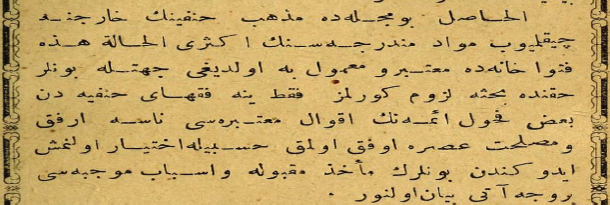
Commentaries on the Mecelle: Affirming Its Late Hanafi Character
The Process of Legal Continuity and Change in the Mecelle
Ahkām al-ghasb (Rules of Usurpation)67
Written Proofs: Admitted Without Reservations
The Prerequisites for Valid Testimony (shurūt al-shahāda) Revisited
Conclusion
Appendix A




